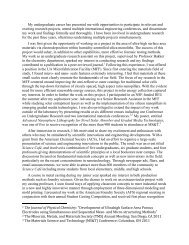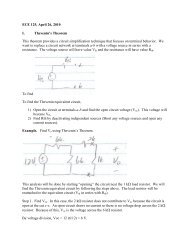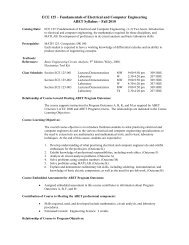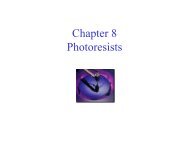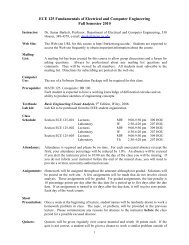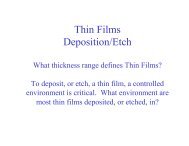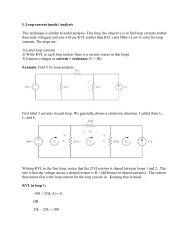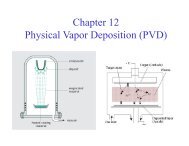Magnetic Materials Review
Magnetic Materials Review
Magnetic Materials Review
You also want an ePaper? Increase the reach of your titles
YUMPU automatically turns print PDFs into web optimized ePapers that Google loves.
Matt’s Quick Guide to Magnetism in <strong>Materials</strong><br />
Matt Jordan<br />
October 12, 2012<br />
1 Introduction<br />
• Where does magnetism come from<br />
• Why are some materials magnets and others not<br />
• How do magnetic materials behave in a magnetic field<br />
1.1 Origins of Magnetism<br />
Magnetism is one part of electromagnetism which is one of the four fundamental<br />
forces (gravity, strong, and weak nuclear forces being the other three).<br />
It is wrong to say that electrical fields or charges “cause” the magnetism since<br />
really magnetism is a manifestation of the electromagnetic force. Yet these<br />
qualities are inseparably linked. We know from Ampere’s Law that magnetic<br />
fields arise when there are changing electric fields and moving charges (current).<br />
Also the field points in a peculiar direction that follows the so called<br />
”right-hand-rule” and is thus perpendicular to the electric field at all times.<br />
The magnetic fields for currents flowing through wires and bent into loops<br />
are depicted in figure 1.<br />
1
Figure 1: <strong>Magnetic</strong> fields: (a) Around a wire (b) in a loop of wire (c) a<br />
another view of a loop of wire<br />
It is safe to say that wherever there are changing electric fields and/or<br />
currents there is also a magnetic field. This is where magnetic properties<br />
come from.<br />
1.2 <strong>Magnetic</strong> Moments<br />
Just as the electric and magnetic fields are useful constructs for understanding<br />
the electromagnetic force, the magnetic moment is useful in understanding<br />
the strength of a magnetic material. For instance, consider a magnetic<br />
rod of length l in a uniform magnetic field, H, and pole strength p. The<br />
torque on the rod can be written:<br />
2
Figure 2: A magnetic rod in a uniform magnetic field<br />
pH sin θ l 2 + pH sin θ l = pHl sin θ (1)<br />
2<br />
And we can define the magnetic moment as:<br />
m = pl (2)<br />
The magnetic moment can be interpreted as the maximum moment of<br />
torque applied to a magnetic material of pole strength p and length l in a<br />
field H. If one were to calculate this for a loop of wire like the one in figure<br />
1 (b) and (c) they would find:<br />
m = πR2 i<br />
10 = Ai<br />
10<br />
Where R is the radius of the wire and i is the current. The factor of 10<br />
arrises from converting between SI and cgs units.<br />
(3)<br />
3
2 Magnetism in materials<br />
2.1 The Bohr Magneton<br />
<strong>Magnetic</strong> moments of wires are great, but what about the magnetic moment<br />
of something interesting like iron or magnetite Well, let’s simplify this<br />
problem a bit by considering the electrons surrounding a single atom. If we<br />
use the Bohr model of the atom we have electrons orbiting a positive nucleus.<br />
These electrons have orbital angular momentum and also intrinsic angular<br />
momentum or spin. Let’s consider the magnetic moment of electrons due<br />
to the orbital angular momentum (Note for atomic magnetic moments it is<br />
customary to use the greek letter µ rather than m). Similarly to the loop of<br />
wire:<br />
( ev<br />
)<br />
µ orbit = πr 2 2πr<br />
= evr in SI units (4)<br />
2<br />
(5)<br />
The momentum of the electron will be an integral multiple of the reduced<br />
Plank constant, . So for the first orbit, n=1:<br />
µ orbit = e<br />
2m<br />
Incidentally the angular momentum due to spin is /2.<br />
magnetic moment due to spin of:<br />
(6)<br />
This leads to a<br />
µ spin = e<br />
2m<br />
These are the same! In fact this value is considered fundamental and so is<br />
given a special name, the Bohr magneton.<br />
2.2 <strong>Magnetic</strong>s of atoms<br />
Lets assume that the magnetic moment of atoms arises solely from the electrons.<br />
We can picture two situations:<br />
(7)<br />
4
1. All the electron magnetic moments cancel out and leave a net magnetic<br />
moment of 0.<br />
2. The cancellation of magnetic moments is only partial leaving a residual<br />
atomic magnetic moment.<br />
The first case results in non-magnetic materials like copper, bismuth, and<br />
graphite. The other case results in magnetic materials. <strong>Magnetic</strong> materials<br />
may be classified by the relationship between their atomic magnetic moments<br />
and their crystal structures. These emergent properties result in para-, ferro-,<br />
antiferro-, and ferrimagnetism.<br />
2.2.1 Paramagnetism<br />
In a paramagnet the atomic magnetic moments are randomly distributed.<br />
By applying a magnetic one can cause them to preferentially align to the<br />
magnetic field. This is a linear relationship, thus the stronger the magnetic<br />
field the more the moments are aligned and the larger the bulk magnetization,<br />
or sum of magnetic moments is. There is also a randomizing element,<br />
temperature. Higher temperatures lead to higher disorder and tend to lessen<br />
the magnetization of a paramagnet.<br />
2.2.2 Ferromagnetism<br />
The atomic magnetic moments in a ferromagnet, on the other hand, are<br />
strongly coupled to one another. Thus, large sections of the magnet are<br />
aligned in a single direction. A section that is aligned in one direction is<br />
called a magnetic domain. Random fluctuations can lead to multiple domains<br />
within a single ferromagnetic material. In a steady state the net<br />
magnetization is 0, but if one were to apply a magnetic field the atomic<br />
magnetic moments opposing the field near the domain wall will experience a<br />
torque and flip to regain equilibrium. This leads to a shift of the domain wall.<br />
Eventually a ferromagnetic material will consist of a single domain. Continued<br />
application of stronger magnetic fields will cause the atomic magnetic<br />
moments to rotate leading to saturation magnetization. This is depicted<br />
schematically in figure 3.<br />
5
Figure 3: Domain wall motion followed by moment rotation<br />
The change caused by this type of magnetization can be displayed in a<br />
hysteresis loop, which you described in the pre-lab. An example hysteresis<br />
loop is displayed in figure 4.<br />
6
Figure 4: Domain wall motion followed by moment rotation<br />
If the loop is wide the magnet is said to be hard or permanent because it<br />
takes a large applied magnetic field to switch it’s magnetization. If the loop<br />
is narrow and tall the material is said to be soft. Soft magnets are useful<br />
because you can get a large magnetic flux out of them after putting in a<br />
small field.<br />
Again temperature tends to counteract magnetization of a ferromagnet.<br />
Above a certain temperature, called the Currie temperature or T C , a ferromagnet<br />
is randomized and acts like a paramagnet.<br />
2.2.3 Antiferromagnets<br />
Like ferromagnets, antiferromagnets consist of materials whose atomic magnetic<br />
moments are strongly coupled. Only in this case adjacent atomic planes<br />
are coupled anti-parallel to each other. Thus at low temperatures they have<br />
only a small magnetic susceptibility. Again like ferromagnets at a certain<br />
temperature, called the Ne’el temperature or T N , antiferromagnets are randomized<br />
and act like paramagnets.<br />
7
2.2.4 Ferrimagnets<br />
We do not use ferrimagnets, also called ferrites, in this lab, but for completeness<br />
I’ll describe them here. A ferrite is like an antiferromagnet in that the<br />
adjacent atomic planes are antiparallel to each other. The difference here is<br />
that the planes contain different materials and thus have different magnetic<br />
moments leading to larger reminance magnetizations than antiferromagnetics.<br />
Ferrites can also be made out of ceramic materials and other materials<br />
that do not conduct electricity meaning that they are not susceptible to eddy<br />
currents, one of the main sources of resistance for ferromagnetic materials. In<br />
structures like transformers where they need the properties of ferromagnetics<br />
without eddy currents a combination of ferrites and ferromagnets is used.<br />
Also similar to ferromagnets, above the curie temperature the magnetization<br />
is randomized and they act like paramagnets.<br />
3 Overview<br />
• Where does magnetism come from<br />
Magnetism is part of the electromagnetic force and is present whenever<br />
there are changing electric fields or moving charges.<br />
• Why are some materials magnets and others not<br />
Depending on the arrangement of electron magnetic moments the overall<br />
atomic magnetic moment either cancels completely (non- or diamagnetic)<br />
or cancels only partially leading to magnetic materials.<br />
• How do magnetic materials behave in a magnetic field<br />
Depending on the coupling of atomic magnetic moments different magnetic<br />
materials react differently to magnetic fields and temperatures.<br />
The effect of temperature and the alignments are summarized in figure<br />
5.<br />
8
Figure 5: Saturation Magnetization and Susceptibility vs. Temperature<br />
9



